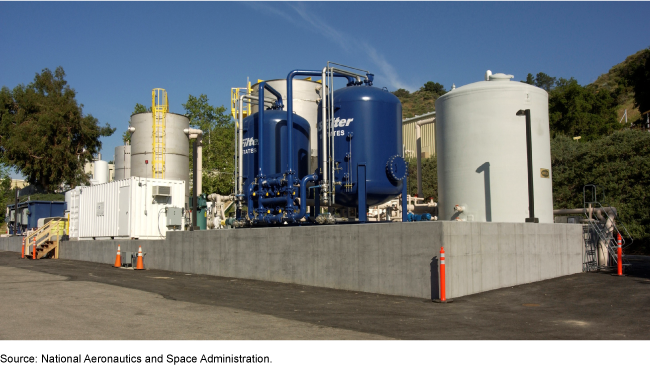Environmental Liabilities: NASA's Reported Financial Liabilities Have Grown, and Several Factors Contribute to Future Uncertainties
Fast Facts
In FY 2019, NASA reported being responsible for $1.7 billion in environmental liabilities for restoration projects to address contamination resulting from mission activities such as rocket testing—a 45% increase from FY 2014. NASA had 14 locations in need of cleanup in FY19. Most of the increase occurred at one location due to stringent soil cleanup requirements that NASA had not anticipated.
NASA is still gathering information on the cost of some still-developing restoration projects. In addition, new or changing cleanup requirements may increase or decrease NASA's future environmental liabilities and the federal government's fiscal exposure.
A plant at the Jet Propulsion Laboratory treats contaminated groundwater for drinking.

Highlights
What GAO Found
The National Aeronautics and Space Administration (NASA) estimated cleanup and restoration across the agency would cost $1.9 billion as of fiscal year 2020, up from $1.7 billion in fiscal year 2019. This reflects an increase of $724 million, or 61 percent, from 2014. NASA identified contamination at 14 centers around the country, as of 2019. Five of the 14 centers decreased their environmental liabilities from 2014 to 2019, but liability growth at the other centers offset those decreases and contributed to the net increase in environmental liabilities. Santa Susana Field Laboratory, California, had about $502 million in environmental liabilities growth during this period (see fig.). Nearly all this growth resulted from California soil cleanup requirements that NASA did not anticipate.
These NASA Centers Reported Increases or Decreases in Restoration Project Environmental Liabilities Greater Than $10 Million Between Fiscal Years 2014 and 2019

NASA's reported fiscal year 2019 environmental liabilities estimate for restoration projects does not include certain costs, and some factors may affect NASA's future environmental liabilities, potentially increasing or decreasing the federal government's fiscal exposure. Certain costs are not included in the fiscal year 2019 estimate because some projects are in a developing stage where NASA needs to gather more information to fully estimate cleanup costs. Further, NASA limits its restoration project estimates to 30 years, as the agency views anything beyond 30 years as not reasonably estimable. Sixty of NASA's 115 open restoration projects in fiscal year 2019 are expected to last longer than 30 years. With regard to factors that could affect future environmental liabilities, NASA is assessing its centers for contamination of some chemicals it had not previously identified but does not yet know the impact associated cleanup will have on the agency's liabilities in part because standards for cleaning up these chemicals do not yet exist. New cleanup requirements for emerging contaminants could increase NASA's environmental liabilities and create additional fiscal exposure for the federal government. Additionally, NASA is committed, through an agreement with the state of California, to clean soil at Santa Susana Field Laboratory to a certain standard, but the agency issued a decision in September 2020 to pursue a risk-based cleanup standard, which the state of California has opposed. According to NASA, a risk-based cleanup standard at Santa Susana Field Laboratory could decrease NASA's environmental liabilities and reduce the federal government's fiscal exposure by about $355 million.
Why GAO Did This Study
Decades of NASA's research for space exploration relied on some chemicals that can be hazardous to human health and the environment. NASA identified 14 centers around the country with hazardous chemicals that require environmental cleanup and restoration. NASA's Environmental Compliance and Restoration Program oversees the agency's environmental cleanup. NASA's environmental liabilities estimate is reported annually in the agency's financial statement. Federal accounting standards require agencies responsible for contamination to estimate and report their future cleanup costs when they are both probable and reasonably estimable.
This report describes (1) NASA's environmental liabilities for restoration projects from fiscal years 2014 to 2019—the most recent data available at the time of our review—and (2) factors that could contribute to uncertainties in NASA's current or future environmental liabilities. GAO reviewed NASA financial statements, guidance, and other relevant reports and interviewed NASA officials from headquarters and three centers, selected because of changes in their reported liabilities.
NASA provided technical comments on a draft of this report, which were incorporated as appropriate.
For more information, contact Allison Bawden at (202) 512-3841 or bawdena@gao.gov.
